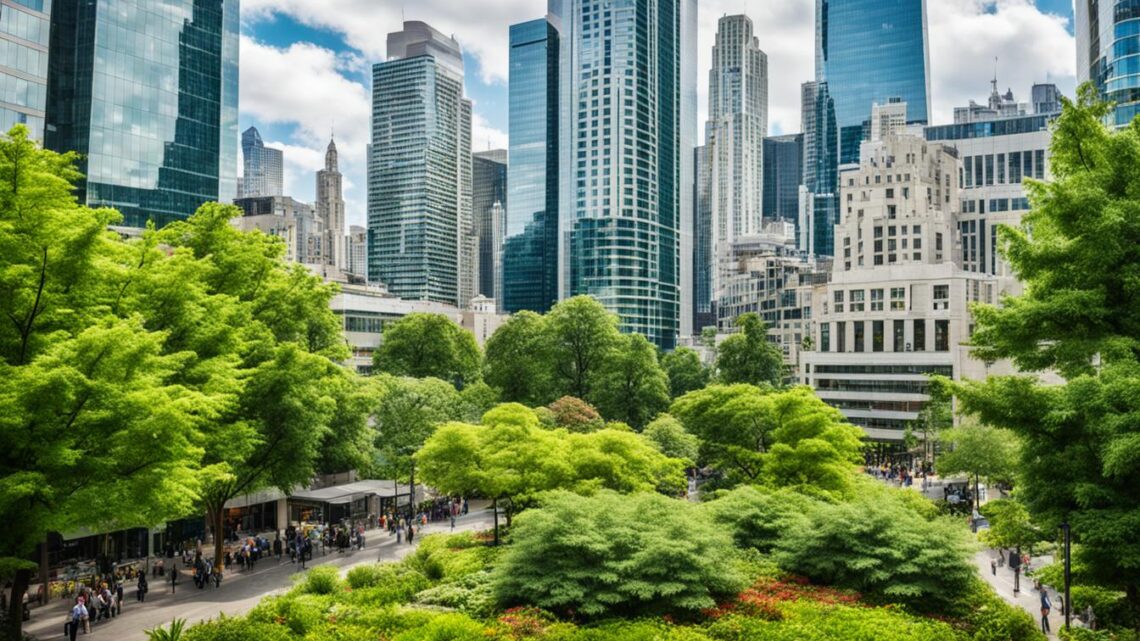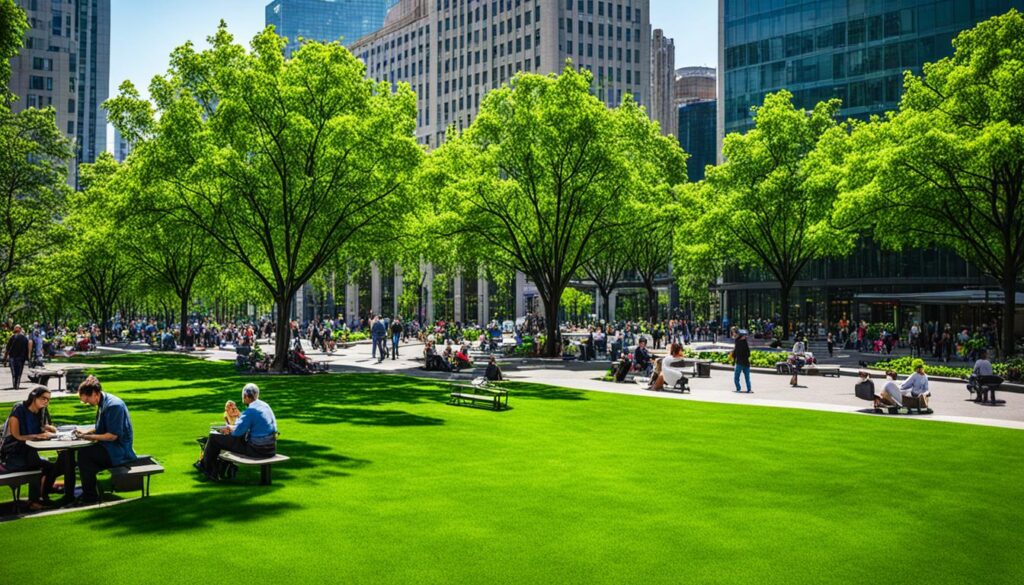
Ever wondered how cities turn into green paradises? Urban forestry is the key. Despite their usual image of high skyscrapers and busy roads, cities are changing. This change includes more trees and green spaces, thanks to a new way of urban planning.
Planting trees in cities does two amazing things. It makes life better for people and helps local businesses. Imagine that happening all over the country. This is the power of urban forestry right now.
So, what is urban forestry, and why does it matter? Get ready to learn about the wonders of urban green spaces. They can really change how we live in our cities.
What is Urban Forestry?
Urban forestry is about taking care of trees and greenery in cities. These urban forests are key to making our cities better and greener. They offer many benefits that make life better for people living in cities.
Importance of Trees in Cities
Trees in the city clean our air, keep it cooler, and help manage water from storms. They absorb CO2, give us oxygen, and filter out pollutants. This process makes our air cleaner and fights against problems like the heat island effect.
Benefits of Urban Green Spaces
Urban green spaces, including parks and gardens, bring many good things. They lower summer heat, help with stormwater, and make areas more valuable. They also offer homes for wildlife and make communities tighter. Being near nature improves our health and mood, lowers noise, and enhances city life.
With cities growing, urban forestry and green infrastructure are even more important. They help cities be sustainable, strong, and nice places for everyone.
Urban Forestry Challenges
Urban areas are growing, and they face big challenges with urban forestry. The heat island effect and the lack of equitable tree distribution are two of the main issues.
Heat Island Effect
In highly developed places with few trees, the heat island effect occurs. Here, pavement and buildings soak up heat. This makes these areas much hotter than places with more nature. Not having enough trees can lead to using more energy for cooling. It also makes the air more polluted and can harm people’s health.
Lack of Equitable Tree Distribution
Many urban areas lack trees, especially those with a history of redlining and discrimination. These places have less access to tree canopy cover and the good things urban forests offer. As a result, people in these areas don’t enjoy cooler summers, cleaner air, and better property values.
Urban Forestry Initiatives
Many communities are starting new projects to grow more trees and make their cities greener. These projects rely heavily on the support and involvement of the whole community. By getting everyone involved, they spread the word, get great ideas, and make sure everyone feels like they own a part of these green spaces.
Community Engagement
Cities are getting their residents to help plan, plant, and look after the urban forests. They do this through teaching programs, planting days, and working together on decisions. This way, the people who live there become the protectors of their own neighborhoods.
Urban Forest Management Plans
On top of community involvement, cities also make detailed plans for their green areas. These management plans help them figure out the best ways to grow, care for, and use trees and other green places. They might even plan ways to use the plants to help with water and to make the city cooler. It’s all about looking at the big picture when it comes to green spaces in the city.
By joining efforts in planning and working with the people, cities are finding new ways to deal with the issues of urban forests. They strive to create places that benefit everyone, making cities better for all who live there.
Environmental Justice and Urban Forestry
The issue of environmental justice is closely tied with urban forestry. In the past, trees and urban green spaces were not fairly spread. Many communities that include people from different backgrounds had fewer trees and faced more heat.
This unequal tree cover leads to health and well-being issues for these communities. So, it’s crucial to ensure everyone gets the good of urban forestry.
Efforts in urban forestry aim to give everyone trees’ benefits like cooler air and better spaces. They’re working to make cities better and fairer for everyone.
Urban forestry can also help with floods and cooler streets. It’s about making areas that were often left out better. Key to these efforts is listening to the locals. By involving them, it helps build stronger communities who care for their shared green areas.

Getting environmental justice in urban forestry is more than adding more trees. It’s about fixing old wrongs and making sure all communities enjoy a green and healthy city. Tackling these issues helps us work toward a fair and green future for everyone.
Planting Trees for a Greener Future
Adding more trees to our cities is critical. Yet, it’s crucial to pick the right tree species for the area. Choosing species that do well in the city will lead to lasting success.
Choosing the Right Trees
Before you plant trees in your city, certain things must be thought of. This includes tree size, water needs, sunlight, and urban stress tolerance. Usually, native trees are your best bet. They fit well with the local environment and need less looking after. Talking to experts and using guides on picking urban trees can guide you to the best choices for your area.
Involving Youth and Education
Getting young people involved and teaching them about trees and the environment is key. When youth help plant and take care of trees, they learn to love nature. This creates a future where more people understand and care for the trees in their area.
Educational programs play a big part. They help kids and young adults grasp why urban trees are so important. These programs cover tree biology, and how to properly plant and look after trees. They spark a sense of responsibility and commitment in anyone who takes part.
Economic Benefits of Urban Forests
Thriving urban forestry impacts local communities in a big way. It leads to more jobs in sectors like arboriculture and urban forest management. Such jobs are essential for economic growth at a local level.
Job Creation
Developing urban forests means more work for those skilled in tree care and landscaping. It’s not just about earning money. They also learn skills that are really important today. By supporting urban forestry, areas create chances for more jobs and help the economy.
Increased Property Values
Research shows that having lots of urban greenery around makes homes and living areas more appealing. As a result, places with many trees or green spaces tend to be in higher demand and cost more. This raises tax money for local use, improving and increasing their green areas further.

| Economic Benefit | Impact |
|---|---|
| Job Creation | Generates employment opportunities in arboriculture, nursery work, and urban forest management, contributing to local economic growth. |
| Increased Property Values | The presence of urban forests and green spaces has been shown to increase property values, leading to higher tax revenues for local governments. |
Urban Forestry Research and Funding
Urban forestry research and funding are key for making our cities greener. The USDA Forest Service is leading this mission. They support many initiatives in urban forestry across the nation.
USDA Forest Service Grants
The USDA Forest Service gives out more than $1 billion in grants. These grants help out many groups, from local communities to universities. Their goal is to make sure everyone has fair access to trees and nature in cities.
These grants are fixing old differences in where green spaces are found in cities. They aim to make sure everyone can enjoy the benefits of a rich, urban forestry system. This work helps with issues like urban heat, air quality, and managing stormwater. So, investing in urban forestry is a big step toward better, greener, and more sustainable cities.
The USDA Forest Service uses grants to empower communities. They help tackle urban forestry challenges and make the most of green areas in cities. This support for research and funding new projects is critical for urban forestry’s future in the U.S.
Sustainable Urban Forestry Practices
To keep urban forests healthy for the long haul, using sustainable practices is key. It involves checking tree health and where they are through tree inventories. It also means having detailed tree maintenance plans to care for them. Plus, tying urban forestry with green infrastructure helps in managing stormwater and cooling cities. This makes the whole urban forest setup more sustainable.
Tree Inventory and Maintenance
Tree inventories are crucial. They show the real story of the urban forest now. Knowing tree specifics helps decide on planting, trimming, or cutting them down. And taking care of trees, like regular checks and cutting away disease, keeps the urban forestry going strong.
Green Infrastructure Integration
Linking urban forestry with green infrastructure is great for everyone. Trees mixed with smart planning can clean stormwater, cool cities, and make them greener. It’s a win for nature and people. It keeps both the city and its forest in good shape together.
| Sustainable Urban Forestry Practices | Benefits |
|---|---|
| Tree Inventory | Provides a comprehensive understanding of the urban forest, enabling informed management decisions. |
| Tree Maintenance | Ensures the long-term health and vitality of the urban forest through regular inspections, pruning, and pest/disease control. |
| Green Infrastructure Integration | Leverages the natural abilities of trees and vegetation to provide essential ecosystem services and promote overall sustainability. |
Urban Forest Case Studies
Los Angeles County and TreePeople are showing the power of trees in a big city. They work to make sure everyone gets to enjoy trees. Los Angeles is the biggest county in the U.S. and it’s turning heads with its plans. These plans fight for more trees in places that need them most.
Los Angeles County’s Urban Forest Plan
Los Angeles County is making its first community forest management plan. This plan is a big deal because it takes on tough urban forestry issues right at the start. It aims to grow the city’s green cover in ways that help fight climate change. Plus, it wants to make sure green spaces are fair for everyone. This all-around effort is great news for making the area better for people to live in.
TreePeople’s «From Redlining to Greenlining» Initiative
TreePeople’s «From Redlining to Greenlining» initiative is making a big difference. They got support from the USDA Forest Service to do it. This plan is about giving more green benefits to areas that have missed out in the past. By planting trees in smart places, everyone can enjoy a fair share of nature. TreePeople is pushing to fix the old problems in sharing green spaces.
Future of Urban Forestry
Urban forestry is becoming more important as cities grow. Urban forests are key for dealing with climate change. They help lower the urban heat island effect, improve air, and handle heavy rain. Making urban forestry a key part of city planning will make cities better places to live.
The future of urban forestry will care more about everyone having urban green spaces. It’s also about getting communities involved and using new nature-based ideas to solve city issues. Planting and looking after trees strategically, alongside green infrastructure, can fight climate change. This makes life better for everyone in the city.
As cities get bigger, the importance of urban forestry grows. Urban forests offer many benefits. They make people healthier, and cities more ready for tough times. This creates cities that are lively, green, and fair for all. It’s a way to help our planet and the people who live here.



